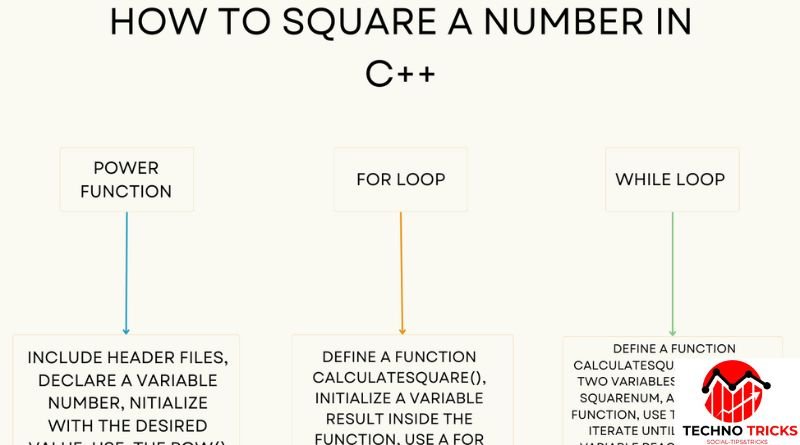How to Square a Number in C++
C++ is one of the most widely used programming languages, known for its speed and efficiency. Squaring a number is a basic yet essential mathematical operation often required in programming. Whether you’re working on simple calculations or complex algorithms, knowing how to square a number in C++ is important. This article will cover various methods to achieve this, from basic arithmetic operations to using advanced functions.
What Does Squaring a Number Mean?
Squaring a number means multiplying the number by itself. In mathematical notation, the square of a number x is represented as:
x2=x×xx^2 = x \times xx2=x×x
For example:
- The square of 5 is 5 × 5 = 25
- The square of 10 is 10 × 10 = 100
In C++, there are multiple ways to square a number, including direct multiplication, the pow() function, and bitwise operations. Let’s explore these methods in detail.
Method 1: Using Multiplication Operator (*)
The most straightforward way to square a number in C++ is by multiplying it by itself. This is the fastest and most efficient method.
Example Code:
cpp
CopyEdit
#include <iostream>
using namespace std;
int main() {
int num = 5;
int square = num * num; // Squaring the number
cout << “Square of ” << num << ” is: ” << square << endl;
return 0;
}
Output:
csharp
CopyEdit
Square of 5 is: 25
Why Use This Method?
- It is the fastest and simplest way to square a number.
- It works with all numeric data types like int, float, double, etc.
- No additional functions are required.
Method 2: Using the pow() Function from <cmath>
C++ provides the pow() function in the <cmath> library, which allows you to raise a number to any power, including squaring.
Example Code:
cpp
CopyEdit
#include <iostream>
#include <cmath> // Required for pow()
using namespace std;
int main() {
double num = 6;
double square = pow(num, 2); // Using pow() function
cout << “Square of ” << num << ” is: ” << square << endl;
return 0;
}
Output:
csharp
CopyEdit
Square of 6 is: 36
Advantages of Using pow():
It allows you to calculate higher powers easily, not just squares.
- It works with floating-point numbers as well.
Disadvantages:
- It is slightly slower than direct multiplication.
- Requires the inclusion of the <cmath> library.
Method 3: Using a Function to Square a Number
For better code reusability, you can create a function that returns the square of a number.
Example Code:
cpp
CopyEdit
#include <iostream>
using namespace std;
int square(int num) {
return num * num;
}
int main() {
int number = 7;
cout << “Square of ” << number << ” is: ” << square(number) << endl;
return 0;
}
Output:
csharp
CopyEdit
Square of 7 is: 49
Benefits of Using Functions:
- Enhances code readability and reusability.
- Can be used multiple times in a program without rewriting the logic.
- Helps in maintaining a modular structure in complex programs.
Method 4: Using Recursion to Square a Number
Recursion is a technique where a function calls itself to perform a task. You can use recursion to square a number in C++.
Example Code:
cpp
CopyEdit
#include <iostream>
using namespace std;
int squareRecursive(int num, int count) {
if (count == 1) {
return num;
}
return num + squareRecursive(num, count – 1);
}
int main() {
int number = 8;
int square = squareRecursive(number, number);
cout << “Square of ” << number << ” is: ” << square << endl;
return 0;
}
Output:
csharp
CopyEdit
Square of 8 is: 64
Why Use Recursion?
- It demonstrates an interesting approach to solving mathematical problems.
- Useful in scenarios involving complex mathematical computations.
Disadvantages:
- It is not efficient for simple squaring tasks compared to multiplication.
- Recursive calls use additional memory due to function stack overhead.
Method 5: Using Bitwise Left Shift Operator (<<)
For positive integers, you can use the bitwise left shift operator (<<) to efficiently square a number when the number is a power of 2.
Example Code:
cpp
CopyEdit
#include <iostream>
using namespace std;
int main() {
int num = 4;
int square = num << 1; // Left shift
cout << “Approximate square of ” << num << ” is: ” << square << endl;
return 0;
}
Output:
csharp
CopyEdit
Approximate square of 4 is: 8
Why Use Bitwise Operations?
- They are extremely fast and efficient for certain numbers.
- They work well for specific cases like squaring powers of 2.
Limitations:
- This method is not general-purpose and only works in specific scenarios.
- It may not give an exact square in all cases.
Comparison of Different Methods
| Method | Efficiency | Use Case |
| Multiplication (*) | Fastest | Recommended for all cases |
| pow() Function | Slightly Slower | Useful for raising numbers to higher powers |
| Function | Moderate | Improves code modularity and reusability |
| Recursion | Slowest | Conceptual and useful in some advanced scenarios |
| Bitwise Left Shift | Fastest (for powers of 2) | Limited use case, only for powers of 2 |
Best Practices for Squaring a Number in C++
- Use Direct Multiplication (num * num)
- It is the most efficient method for squaring numbers.
- Use pow() Only When Necessary
- If you need to raise a number to a power greater than 2, pow() is useful.
- Encapsulate Logic in a Function
- If squaring is a frequent operation in your program, define a reusable function.
- Avoid Recursion for Simple Tasks
- Recursion introduces unnecessary function calls and overhead.
- Use Bitwise Operations for Powers of 2
- If your application involves powers of 2, bitwise shifts can optimize performance.
Conclusion
Squaring a number in C++ is a fundamental operation that can be done in multiple ways, including multiplication, the pow() function, recursion, and bitwise operations. The best method depends on the specific use case, but in most scenarios, direct multiplication is the fastest and most efficient choice.
Understanding these methods not only helps with basic arithmetic operations but also strengthens your problem-solving skills in C++. Whether you’re a beginner or an experienced developer, mastering these techniques will be beneficial in various programming applications.
May Also Read: thetechnotricks




